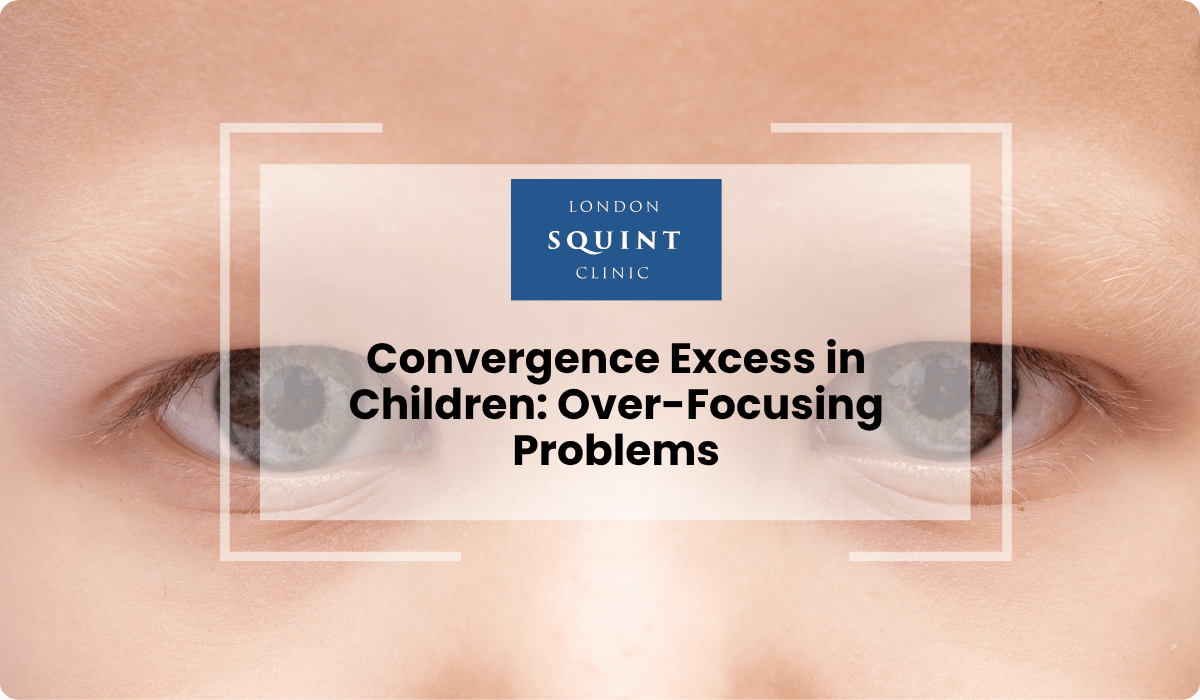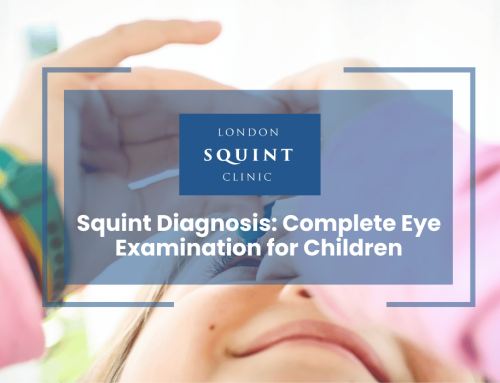Convergence Excess in Children: Over-Focusing Problems
Essential Insights for Parents: Understanding Your Child’s Vision
Convergence excess is a binocular vision disorder where children’s eyes turn inward excessively during near tasks, causing significant reading difficulties and eye strain.
Watch for warning signs like headaches after reading, covering one eye, or avoiding close work—these symptoms are often mistaken for attention or behavioral problems.
Standard vision screenings often miss convergence disorders; a comprehensive eye examination with a pediatric specialist is essential for proper diagnosis.
Effective treatments include prescription glasses, vision therapy, and ergonomic adjustments—most children show significant improvement within 3-6 months of consistent treatment.
Implementing the 20-20-20 rule (looking at something 20 feet away for 20 seconds every 20 minutes) can help prevent visual stress during reading and screen time.
Table of Contents
- What Is Convergence Excess in Children?
- Signs and Symptoms of Over-Focusing Problems in Kids
- How Convergence Excess Affects Reading and Learning
- Why Do Children’s Eyes Cross When Reading?
- Diagnosing Convergence Excess and Near Vision Squint
- Treatment Options for Childhood Convergence Disorders
- Preventing Eye Strain and Managing Visual Stress
What Is Convergence Excess in Children?
Convergence excess is a binocular vision disorder that occurs when a child’s eyes have a tendency to turn inward (converge) more than necessary when focusing on near objects, particularly during reading or close-up work. This condition represents an imbalance in the visual system where the eyes over-converge relative to the accommodation (focusing) required for clear vision at near distances.
In normal visual function, our eyes work together as a team, turning inward in a coordinated manner when we look at close objects. This process, called convergence, is automatically linked with accommodation (the focusing mechanism of the eye). In children with convergence excess, this delicate balance is disrupted, causing the eyes to turn inward excessively when attempting near tasks.
Convergence excess differs from other forms of esotropia (inward turning eyes) as it typically manifests only during near vision activities and may not be apparent when the child is looking at distant objects. This condition is particularly concerning in school-aged children as it directly impacts their ability to perform essential academic tasks like reading, writing, and computer work.
Signs and Symptoms of Over-Focusing Problems in Kids
Children with convergence excess and over-focusing problems often display a range of symptoms that parents and teachers should be vigilant about. These symptoms typically worsen after prolonged near vision activities and may include:
- Eyestrain or discomfort after reading or close work
- Headaches, particularly in the forehead or around the eyes
- Blurred vision, especially when shifting focus from near to far
- Double vision (diplopia) during reading
- Difficulty maintaining concentration during near tasks
- Covering or closing one eye while reading
- Excessive blinking or rubbing eyes
- Unusual head tilting or positioning when reading
- Avoidance of reading or near work
- Reduced reading comprehension despite adequate reading skills
Many children with convergence excess develop adaptive behaviours to cope with their visual discomfort. They might frequently take breaks during reading, hold books at unusual distances, or avoid reading altogether. Unfortunately, these symptoms are often mistaken for behavioural issues, attention problems, or learning disabilities, leading to delayed diagnosis and treatment of the underlying visual condition.
How Convergence Excess Affects Reading and Learning
Convergence excess can significantly impact a child’s educational experience and academic performance. When a child struggles with over-focusing problems, the act of reading becomes physically demanding and uncomfortable, creating a cascade of learning challenges.
During reading, children with convergence excess must exert constant effort to prevent their eyes from turning inward excessively. This continuous struggle diverts cognitive resources away from comprehension and content processing. Instead of focusing on understanding the text, the child’s brain is preoccupied with maintaining proper eye alignment.
The visual stress caused by convergence excess often leads to reduced reading stamina. Children may be able to read effectively for short periods but quickly develop fatigue, losing their place, skipping lines, or experiencing blurred vision. This pattern can manifest as apparent reading difficulties that are actually symptoms of an underlying visual processing problem.
Research suggests a significant correlation between binocular vision disorders like convergence excess and academic performance. Children with undiagnosed and untreated visual processing issues may develop negative associations with reading and learning, leading to decreased motivation and self-confidence. Proper intervention with children’s glasses and vision therapy can often resolve these issues, allowing the child to reach their full academic potential.
Why Do Children’s Eyes Cross When Reading?
The phenomenon of eyes crossing during reading, particularly in children with convergence excess, stems from the intricate relationship between accommodation (focusing) and convergence (eye alignment) in the visual system. Understanding this connection helps explain why some children experience near vision squint during reading activities.
When we view objects up close, two simultaneous processes occur: our eyes must focus (accommodate) to see the object clearly, and they must turn inward (converge) to maintain single vision. These processes are neurologically linked in what’s called the accommodative-convergence reflex. For every unit of accommodation, there is a proportional amount of convergence that naturally occurs.
In children with convergence excess, this relationship is imbalanced. They have a higher accommodative convergence to accommodation (AC/A) ratio, meaning that for each unit of focusing effort, their eyes produce an excessive amount of convergence. This results in the eyes crossing more than necessary during near tasks like reading.
Several factors can contribute to this condition:
- Uncorrected hyperopia (long-sightedness) requiring increased focusing effort
- Genetic predisposition to binocular vision disorders
- Developmental delays in the visual system
- Neurological factors affecting eye muscle control
- Excessive near work without adequate visual breaks
This over-convergence during reading is not merely a cosmetic concern but represents a functional vision problem that can significantly impact a child’s learning experience and comfort during near vision tasks.
Diagnosing Convergence Excess and Near Vision Squint
Accurate diagnosis of convergence excess requires a comprehensive paediatric vision assessment that goes beyond standard vision screenings conducted at schools or during routine check-ups. These specialised evaluations assess not only visual acuity but also how effectively the eyes work together as a team.
The diagnostic process typically includes:
- Comprehensive eye examination: Assessing visual acuity, refractive error, and eye health
- Binocular vision testing: Evaluating how well the eyes work together
- Accommodative facility testing: Measuring the eyes’ ability to quickly change focus
- Convergence assessment: Determining the near point of convergence and convergence amplitude
- AC/A ratio measurement: Calculating the relationship between accommodation and convergence
- Cover testing: Observing eye alignment at various distances
- Fusional vergence testing: Assessing the eyes’ ability to maintain alignment under varying conditions
Paediatric ophthalmologists and orthoptists use specialised equipment and techniques designed to be engaging and child-friendly. These professionals are trained to differentiate convergence excess from other forms of esotropia and binocular vision disorders that may present with similar symptoms.
Early diagnosis is crucial, as convergence excess can be effectively managed when identified promptly. Parents should seek a comprehensive eye examination if their child shows signs of visual discomfort during reading or near work, even if they have passed basic vision screenings.
Treatment Options for Childhood Convergence Disorders
Effective management of convergence excess in children typically involves a multifaceted approach tailored to the specific needs of each child. Treatment aims to restore normal binocular vision, reduce symptoms, and improve visual comfort during near tasks.
Optical Correction: Prescription glasses are often the first-line treatment for convergence excess, particularly when hyperopia (long-sightedness) is present. By correcting refractive errors, glasses reduce the accommodative demand, which in turn decreases the linked convergence response. In some cases, bifocal or progressive lenses may be prescribed to provide additional focusing support for near tasks.
Vision Therapy: Structured vision therapy programmes can be highly effective for convergence disorders. These therapeutic exercises aim to:
- Improve convergence control and flexibility
- Enhance fusional vergence ranges (the ability to maintain single vision)
- Normalise the accommodative-convergence relationship
- Develop more efficient visual processing skills
Prism Glasses: In some cases, prisms may be incorporated into spectacle lenses to help align the eyes more comfortably, reducing the effort needed to maintain single vision during near tasks.
Orthoptic Exercises: Home-based eye exercises prescribed by orthoptists or vision therapists can complement in-office treatment. These might include pencil push-ups, Brock string exercises, or computer-based vision therapy activities.
Lifestyle Modifications: Implementing the 20-20-20 rule (taking a 20-second break to look at something 20 feet away every 20 minutes of near work) and ensuring proper reading ergonomics can help manage symptoms.
Treatment duration varies depending on the severity of the condition and the child’s response to therapy, but most children show significant improvement within 3-6 months of consistent treatment.
Preventing Eye Strain and Managing Visual Stress
While some factors contributing to convergence excess may be inherent to a child’s visual system, several strategies can help prevent excessive eye strain and manage visual stress, particularly for children who are predisposed to binocular vision problems.
Ergonomic Considerations:
- Ensure proper lighting for reading and near work (bright enough but without glare)
- Position reading material at an appropriate distance (approximately 40 cm or the Harmon distance—the distance from elbow to middle knuckle)
- Maintain good posture with feet flat on the floor and back supported
- Position computer screens slightly below eye level and at arm’s length
Digital Device Management:
- Implement the 20-20-20 rule during screen time
- Consider blue light filtering glasses for extended digital device use
- Adjust screen brightness and contrast for comfort
- Increase text size to reduce visual demand
- Use appropriate apps and settings that enhance readability
Visual Hygiene Practices:
- Schedule regular comprehensive eye examinations, not just vision screenings
- Balance near work with distance activities
- Encourage outdoor play, which has been shown to benefit visual development
- Ensure adequate breaks during intensive near visual tasks
- Be vigilant about signs of visual discomfort and address them promptly
For children already diagnosed with convergence excess, consistent adherence to prescribed treatments and regular follow-up appointments are essential for managing the condition effectively and preventing recurrence of symptoms. With appropriate intervention and preventive measures, most children with convergence excess can achieve comfortable, efficient binocular vision for both academic and recreational activities.
Frequently Asked Questions
Can convergence excess resolve on its own as a child grows?
Convergence excess rarely resolves completely without intervention. While some children may develop compensatory strategies, the underlying visual imbalance typically persists and can worsen with increased academic demands. Early diagnosis and appropriate treatment—including prescription glasses, vision therapy, and/or orthoptic exercises—provide the best outcomes and prevent potential long-term learning difficulties.
How can I tell if my child’s reading difficulties are due to convergence excess rather than a learning disability?
Look for specific visual behaviors such as covering one eye while reading, excessive blinking, headaches after reading, or complaints about words moving on the page. Unlike learning disabilities, children with convergence excess often have good comprehension when material is read to them and may show inconsistent reading performance that worsens with fatigue. A comprehensive eye examination with binocular vision testing can differentiate between visual processing issues and learning disabilities.
What age can convergence excess typically be diagnosed in children?
Convergence excess can be diagnosed as early as age 3-4, though it’s most commonly identified when children begin formal education (ages 5-7) and face increased near vision demands. Specialized pediatric vision assessments can detect binocular vision disorders even in young children using age-appropriate testing methods. Early diagnosis is crucial as treatment outcomes are generally better when intervention begins before visual habits become firmly established.
Does screen time worsen convergence excess in children?
Extended screen time can exacerbate symptoms of convergence excess due to the sustained near focus required. Digital devices often demand intense visual concentration at fixed distances, increasing accommodative effort and the associated excessive convergence response. While screens don’t cause the underlying condition, they can trigger more frequent and severe symptoms. Implementing regular visual breaks, proper ergonomics, and screen time limits can help manage symptoms.
How long does vision therapy treatment typically last for convergence excess?
Vision therapy for convergence excess typically requires 12-24 weekly sessions over 3-6 months, combined with daily home exercises. Treatment duration varies based on severity, patient compliance, and individual response to therapy. Most children show significant improvement within the first 8-12 weeks of consistent therapy. Follow-up assessments are recommended to ensure the maintenance of improved visual skills and to address any regression.
Can children with convergence excess participate in sports and other activities normally?
Yes, children with convergence excess can typically participate in sports and other activities without restrictions. In fact, many sports that emphasize distance vision may provide natural relief from near vision stress. However, activities requiring sustained near focus (like certain video games, detailed crafts, or reading) may trigger symptoms if performed for extended periods without breaks. Proper treatment of the underlying condition generally allows for comfortable participation in all age-appropriate activities.
Find out if you are suitable for Double Vision Treatment
Not everyone is eligible for double vision surgery.
Find out if you could benefit from this life-changing surgery by taking the quick self-suitability quiz below:
Our most popular procedures

Hello, I’m Nadeem Ali
I’m one of the few eye surgeons in the world with 100% focus on Squint and Double Vision Surgery.
I have 24 years of eye surgery experience, and worked for 13 years as a Consultant at London’s renowned Moorfields Eye Hospital.
In 2023, I left the NHS to focus fully on treating patients from across the world at the London Squint Clinic. You can read more about me here.
There’s lots of information on the website about: squint surgery, double vision surgery and our pricing.
The most rewarding part of my job is hearing patients tell me how squint or double vision surgery has changed their lives. You can hear these stories here.
Mr Nadeem Ali
MA MB BChir MRCOphth FRCSEd(Ophth)





